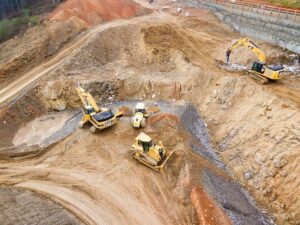Sustainable Earthwork in Kentucky: Environmental Compliance Guide
Earthwork environmental impact poses significant challenges for construction projects in Kentucky, from regulatory hurdles to ecological preservation. Contractors and project managers often face costly delays and fines when environmental factors are overlooked. This guide defines key concepts, outlines compliance requirements, and offers practical strategies for sustainable excavation, site grading, erosion control, waste management, stormwater protection, and state-specific regulations. You will learn how Environmental Impact Assessments (EIAs), Construction Environmental Management Plans (CEMPs), best management practices (BMPs), eco-friendly techniques, recycling strategies, stormwater pollution prevention, and Kentucky DEP permits interconnect to minimize ecological disruption and ensure project success. Whether you manage a commercial build or civil works contract, these insights will support your decision-making and enhance project sustainability while aligning your operations with Earth Works, LLC’s commitment to responsible excavation and civil works services.
What Is an Environmental Impact Assessment (EIA) for Earthwork Projects?
An Environmental Impact Assessment (EIA) is a formal evaluation process that identifies, predicts, and mitigates potential environmental effects of earthwork activities, ensuring regulatory compliance and sustainable project outcomes. By systematically analyzing soil disturbance, water quality risks, habitat disruption, noise, and air emissions, the EIA mechanism integrates scientific data and stakeholder input to protect ecosystems. For general contractors and civil works managers, an EIA supports informed planning, reduces liability, and demonstrates environmental stewardship. Earth Works, LLC collaborates with clients to incorporate EIA recommendations into excavation designs, enabling projects to proceed smoothly under Kentucky DEP guidelines.
What Are the Key Steps in the EIA Process for Earthwork?
The EIA process for earthwork projects involves five key steps: initial screening, scoping, impact analysis, mitigation planning, and reporting to regulatory authorities.
- Screening determines whether a full EIA is required based on project scale.
- Scoping defines the assessment’s scope and key environmental receptors.
- Impact analysis evaluates soil erosion, water runoff, and habitat loss.
- Mitigation planning designs measures such as sediment traps or buffer zones.
- Reporting compiles findings into an EIA report submitted to the Kentucky DEP.
These steps establish a clear path from concept to compliance, preparing projects for permitting and community consultation.
How Does an EIA Benefit Earthwork and Construction Projects?
An EIA benefits construction projects by enhancing risk management, securing permits faster, and fostering community trust through transparency. By quantifying potential impacts and proposing targeted controls—such as silt fences and revegetation—an EIA reduces erosion, protects watercourses, and preserves soils. Projects guided by EIAs often experience fewer regulatory delays and lower remediation costs. Integrating EIA findings early allows Earth Works, LLC to optimize excavation sequences and equipment selection, improving operational efficiency while upholding environmental standards.
What Are Kentucky-Specific EIA Regulatory Requirements?
Kentucky regulations mandate that earthwork projects above specified disturbance thresholds undergo EIA review by the Department for Environmental Protection (DEP). Key requirements include submitting a Notice of Intent, detailed site plans showing grading limits, and water quality protection measures. The DEP enforces erosion and sediment control standards under KRS Chapter 224, with mandatory monitoring and reporting intervals. Projects impacting wetlands or endangered species require additional approvals. Aligning with these regulations ensures projects avoid fines and maintain uninterrupted progress.
Kentucky Environmental Law Handbook: Compliance and Regulations
ABSTRACT: Authored by one of the nation’s preeminent environmental law firms, this handbook offers concise, readily comprehensible explanations of your state compliance obligations. It provides comprehensive coverage of hazardous and solid waste disposal; air, water, and natural resources regulations; the state’s organisational structure; requisite permits and reports; the interplay between federal and state regulations; and more.
KENTUCKY
How Do Construction Environmental Management Plans (CEMPs) Support Earthwork Sustainability?
A Construction Environmental Management Plan (CEMP) is a comprehensive document outlining how a project will manage and monitor its environmental impacts throughout construction, ensuring compliance and sustainability. By defining roles, responsibilities, and performance indicators for erosion control, waste management, dust suppression, noise mitigation, and water protection, a CEMP creates a structured framework for site management. Projects that implement robust CEMPs benefit from consistent environmental performance, reduced rework, and enhanced stakeholder confidence. Earth Works, LLC develops CEMPs tailored to Kentucky’s terrain and regulatory context, embedding best practices into every excavation and grading activity.
What Are the Essential Components of a CEMP for Earthwork?
A CEMP for earthwork must include:
- Organizational roles and communication protocols for environmental oversight.
- Site-specific risk assessments covering soil erosion, runoff, and habitat sensitivity.
- Mitigation measures such as sediment basins, cover crops, and drainage controls.
- Inspection and monitoring schedules with corrective action procedures.
- Training plans for personnel on environmental responsibilities.
These components ensure that all aspects of earthmoving activities are managed systematically, reducing environmental risk and aligning with project goals.
How Is a CEMP Developed and Implemented in Kentucky?
Developing and implementing a CEMP in Kentucky begins with a baseline environmental audit of site conditions and regulatory obligations under the Kentucky DEP. Earth Works, LLC collaborates with clients to map sensitive areas, establish control points, and design monitoring protocols. Implementation includes on-site installation of BMPs, regular inspections, and documentation of performance metrics. Any deviations trigger immediate corrective actions, documented in compliance reports. This continuous feedback loop supports both regulatory adherence and adaptive management throughout the project lifecycle.
Why Is Ongoing CEMP Monitoring Critical for Environmental Compliance?
Ongoing CEMP monitoring verifies that erosion controls, waste segregation, and water protection measures function as intended and adapt to changing site conditions. Regular inspections detect early signs of sediment breaches or uncontrolled runoff, prompting timely maintenance. Monitoring reports satisfy Kentucky DEP audit requirements and build client confidence in project transparency. By continuously measuring performance against predefined thresholds, contractors can demonstrate due diligence and minimize the likelihood of enforcement actions or project shutdowns.
What Are the Best Soil Erosion and Sediment Control Practices in Earthwork?
Effective soil erosion and sediment control practices prevent sediment-laden runoff from degrading waterways and destabilizing slopes. By implementing a suite of BMPs—such as silt fences, sediment basins, and vegetative buffers—projects can dramatically reduce sediment yield. Early planning that phases earthmoving, preserves existing vegetation, and installs perimeter controls further limits disturbance. These measures improve water quality, protect habitats, and maintain site integrity, supporting regulatory compliance and community relations.
What Causes Soil Erosion on Construction Sites?
Soil erosion on construction sites arises from:
- Rain impact and surface runoff washing away topsoil.
- Wind detaching loose soil particles in exposed areas.
- Grading and earthmoving that create steep, unvegetated slopes.
- Inadequate or missing erosion controls around disturbed zones.
Understanding these factors guides the selection and placement of erosion control measures, reducing sediment transport and stabilizing soil.
Which Best Management Practices (BMPs) Effectively Control Sediment?
The following table compares key BMPs for sediment control on construction sites:
These BMPs enhance site resilience by intercepting sediment, slowing runoff, and promoting soil settlement, forming a layered defense against erosion.
How Do You Plan and Maintain an Effective Erosion and Sediment Control Plan?
An effective control plan begins with a site assessment identifying high-risk areas and soil types, followed by design of perimeter controls and internal measures. Installation precedes earthmoving, and routine inspections ensure functionality after rainfall events. Maintenance actions include repairing damaged fences, desilting basins, and re-establishing vegetation. Clear documentation of inspections and repairs supports regulatory audits and informs adaptive improvements, sustaining control effectiveness throughout project phases.
How Can Sustainable Excavation and Site Grading Minimize Environmental Impact?
Sustainable excavation and site grading focus on reducing land disturbance, conserving topsoil, and optimizing machinery to lower emissions and fuel consumption. By employing phased excavation, selective material reuse, and fuel-efficient equipment, projects minimize carbon footprint while preserving soil structure. Proper grading directs stormwater into designed channels, preventing ponding and erosion. These eco-friendly practices enhance site stability, reduce waste hauling, and demonstrate commitment to green construction.
What Are Eco-Friendly Excavation Practices for Earthwork?
Eco-friendly excavation practices include:
- Limiting the footprint by staging smaller work areas sequentially.
- Using GPS-guided machinery to reduce over-digging and fuel usage.
- Stockpiling topsoil separately for later site rehabilitation.
- Recycling subsoil for backfill or landscaping purposes.
These methods lower environmental impact, reduce machinery emissions, and preserve valuable soil resources for post-construction restoration.
How Does Proper Site Grading Protect Drainage and Soil Stability?
Proper grading establishes gentle slope gradients and directs water into designated swales or retention areas, minimizing erosion and surface runoff. By grading to uniform contours, the soil profile remains stable under rainfall, preventing rill formation and landslides. Well-designed drainage channels, lined with erosion controls, manage peak flows and protect downstream water bodies. This hydraulic approach safeguards site integrity and complies with stormwater regulations.
What Are the Benefits of Minimizing Land Disturbance During Earthmoving?
Minimizing land disturbance reduces habitat fragmentation, preserves soil organic matter, and limits invasive species establishment. Fewer exposed areas mean lower erosion risk, less sediment transport, and reduced need for extensive BMPs. Projects achieve cost savings through decreased grading volumes and lower waste disposal fees. For Earth Works, LLC clients, this approach translates into streamlined permitting, faster mobilizations, and demonstrable environmental responsibility.
What Are Effective Waste Management and Recycling Strategies for Earthwork Projects?
Construction waste management encompasses segregation, reuse, and recycling of materials to divert debris from landfills and reduce resource consumption. By separating inert materials, wood, metals, and organics on-site, contractors recover valuable aggregates and minimize disposal costs. Recycling excavated rock and concrete for subbase fill aligns with circular economy principles and reduces demand for virgin materials. Lean construction planning further optimizes material flows, cutting waste generation and enhancing project sustainability.
How Can Construction Waste Be Segregated and Reduced on Site?
Effective on-site segregation involves:
- Designating clearly labeled bins for concrete, metal, wood, and general refuse.
- Training crews to sort materials at source, preventing cross-contamination.
- Implementing just-in-time deliveries to avoid stockpiling excess materials.
- Reusing packaging and pallets for internal logistics.
These actions support material recovery, lower disposal fees, and foster a culture of environmental accountability.
What Are the Opportunities for Recycling Excavated Materials?
Excavated materials such as rock, crushed concrete, and clean fill can be processed into aggregate for roads or grading subbases. Soils with suitable texture may be stabilized for landscaping or embankment construction. Organic debris can be composted to create erosion control amendments. By partnering with local recycling facilities and reprocessing plants, projects close material loops and reduce haul distances, cutting carbon emissions and promoting resource efficiency.
How Do Lean Construction Principles Support Environmental Goals?
Lean construction emphasizes waste elimination, continuous improvement, and efficient workflows. By mapping value streams for material handling and scheduling deliveries to match consumption rates, projects minimize inventory and avoid over-ordering. Just-in-time excavation sequences limit exposed earth, reducing erosion control requirements. Cross-functional teams identify bottlenecks and implement corrective actions, fostering a proactive approach to environmental performance and cost management.
How Is Water Quality Protected Through Stormwater Management in Earthwork?
Stormwater management in earthwork protects water quality by controlling sediment, reducing nutrient runoff, and preventing pollutants from entering waterways. Through a combination of structural controls and treatment methods—such as sediment traps, vegetated swales, and chemical dosage systems—projects capture suspended solids and neutralize contaminants before discharge. Effective stormwater strategies safeguard aquatic ecosystems, comply with Clean Water Act provisions, and support community health.
What Are Common Sources of Water Pollution on Construction Sites?
Water pollution on construction sites originates from:
- Sediment-laden runoff carrying soil fines.
- Fuel and lubricant spills from equipment.
- Concrete washout effluent with high alkalinity.
- Dust bound to stormwater flows.
Identifying these sources enables targeted controls—such as designated washout areas and spill containment systems—to protect downstream water bodies.
What Are Stormwater Pollution Prevention Plans (SWPPP) and Their Role?
A Stormwater Pollution Prevention Plan (SWPPP) is a documented strategy outlining site-specific controls to minimize stormwater contaminants. It includes site maps, BMP descriptions, inspection schedules, and maintenance procedures. Regulatory agencies require SWPPPs under Kentucky’s General Permits for Discharges, ensuring sites implement best practices for sediment control, slip-lined channels, and post-storm evaluations. SWPPPs facilitate compliance and demonstrate proactive environmental management.
Assessment of Water Quality and Sediment Erosion for Fort Knox Construction
New training facilities have been proposed for construction at the Fort Knox Northern Training Complex. These facilities include a digital training range and a complex of droplanding zones and a manoeuvre area. During the review of an Environmental Assessment, concerns were raised regarding sediment erosion and adverse water quality impacts arising from the construction and project. Assessments of existing water quality data and the potential for sediment erosion were conducted to address potential impacts. Water quality data collected between 1995 and 1998 near the study area at the two major rivers, onsite data collected for discharge permit monitoring, data retrieved from the U.S. Environmental Protection Agency’s Storage and Retrieval system (STORET), and real-time discharge data were available for assessing existing conditions. Material loading was estimated using water quality and discharge data. Sediment yield for pre-project and post-project conditions for each alternative was conducted using the Revised Universal Soil Loss Equation, soil characteristics, and terrain slope developed from digital terrain elevation data. Water quality constituents generally fell within acceptable concentration ranges, although total phosphorus concentrations were well above concentration guidelines used for lakes and reservoirs (0.02 mg L⁻¹), and elevated concentrations of solids, nutrients, and faecal coliform were most commonly observed with runoff events. Loading estimates indicated that sediment loads in the Salt River were approximately four times higher than in the Rolling Fork River.
Water Quality and Potential Sediment Erosion for Proposed Construction at Fort Knox, Kentucky, 2001
Which Runoff Control and Treatment Methods Are Most Effective?
The following table summarizes runoff control and treatment options:
Selecting a combination of these methods achieves layered protection, with structural and chemical treatments working in concert to ensure discharge meets water quality standards.
What Are the Key Kentucky Environmental Regulations Affecting Earthwork and Civil Works?
Kentucky’s environmental framework for earthwork operates under the Department for Environmental Protection (DEP) and includes stormwater permits, erosion control regulations, wetland protections, and endangered species reviews. Contractors must secure general permits for stormwater discharges, adhere to KRS Chapter 224 erosion standards, and obtain wetland disturbance authorizations under Section 404 of the Clean Water Act. Compliance reduces legal risks and reinforces community confidence.
Which State and Local Permits Are Required for Earthwork Projects?
- A Notice of Intent for stormwater discharge under the Kentucky General Industrial Stormwater Permit.
- Erosion and sediment control plan approval from the local conservation district.
- Wetland disturbance permits for impacts to federally protected waters.
- Endangered species consultation when work occurs in sensitive habitats.
Securing these authorizations before grading begins prevents delays and aligns with DEP enforcement priorities.
How Do Regulations Impact Project Planning and Execution?
Regulations influence project planning by dictating timing, phasing, and BMP installation before land disturbance. Permitting timelines inform scheduling decisions, while setback requirements shape site layouts. Inspections mandated by the DEP and local authorities require documentation readiness. Early integration of environmental controls into project planning ensures smooth execution and avoids retroactive modifications that can escalate costs and time.
What Are the Consequences of Non-Compliance for Contractors and Project Managers?
Non-compliance can result in stop-work orders, civil penalties, project shutdowns, and reputational damage. The Kentucky DEP enforces fines based on violation severity, ranging from sediment discharges to unapproved wetland impacts. Repeat offenses may trigger bonding requirements or criminal referrals. Adhering to environmental regulations through proactive management and clear documentation safeguards project continuity and reinforces contractor credibility.
Earthwork operations that prioritize environmental considerations not only satisfy regulatory mandates but also deliver long-term value through cost savings, risk reduction, and enhanced stakeholder trust. By applying the practices outlined above—supported by Earth Works, LLC’s expertise in environmentally responsible excavation and civil works—projects throughout Kentucky can achieve sustainable outcomes, protect natural resources, and maintain uninterrupted progress. For tailored guidance on integrating these strategies into your next earthwork project, explore solutions at kyearthworks.com.


